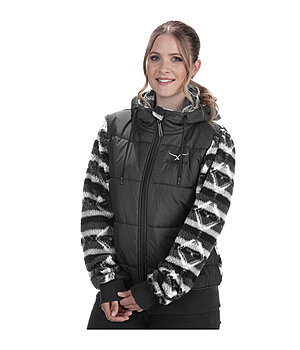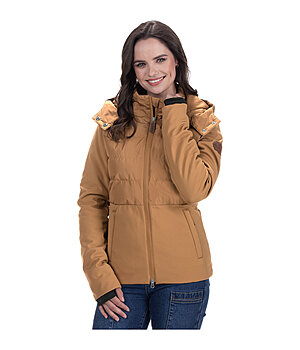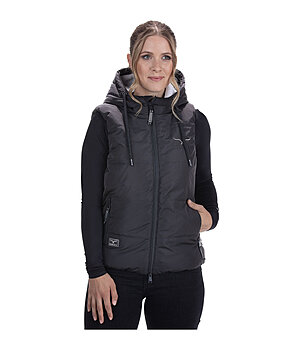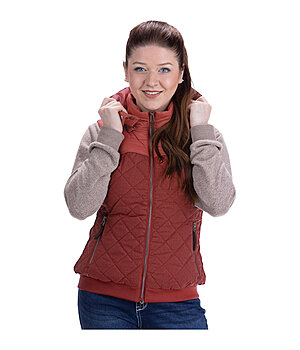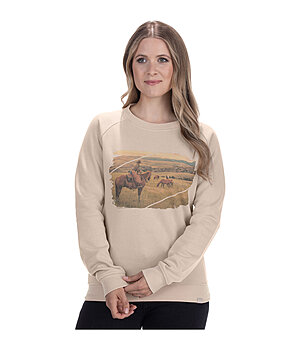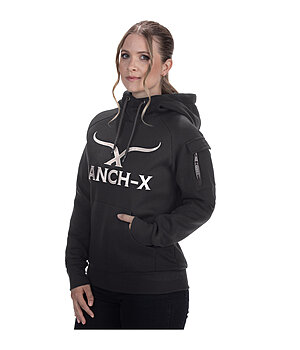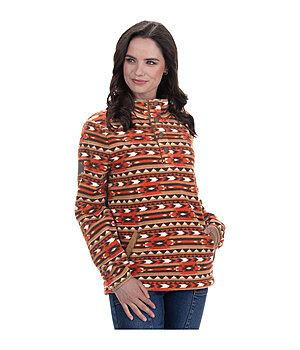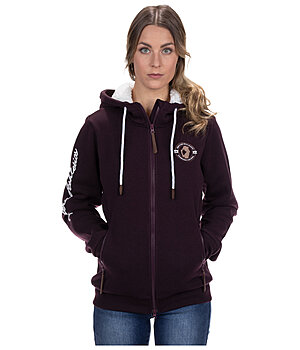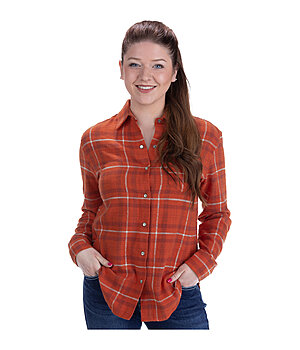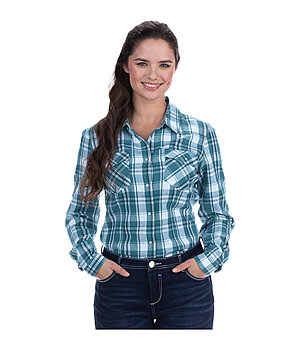What kind of outerwear do you need for western riding?
A classic outfit for western riding is automatically associated with the cowboys from the USA. Casual flannel shirt, comfortable jeans, western boots… and of course the western hat must not be missing. In fact, the trends in the western riding scene are still strongly oriented towards the work clothes of the cowboys, however, in everyday clothing for the stable as well as in western competition fashion, current trends are established again and again that are indispensable.

Competition wear is very different from the everyday outfits for the stable. Therefore, we have created a comprehensive guide on the subject of western competition fashion for you, with which you can find the right outfit for every discipline.
Passionate western riders are usually not only enthusiastic about the riding style, they are closely connected to the cowboy lifestyle, which is also reflected in the clothing for the stable. It should be comfortable and multifunctional. While western riding jeans often only differ in terms of cut and design, there are various versions of western outerwear that can be chosen depending on weather conditions, individual taste as well as the desired purpose.
We present the western outerwear in detail:
1. Western Riding Jackets & Gilets
A good western riding jacket should not restrict the rider’s freedom of movement in the saddle, also when working in the stable, and at the same time offer reliable protection against the individual weather conditions. Material properties, padding and cut determine the intended use. In addition, there is the individual feeling of warmth and the rider’s own need for comfort.
Western riding jackets are usually cut slightly shorter and have an elasticated hem. Since the cantle of a western saddle is more pronounced than the cantle of an English saddle, this type of jacket cut makes it more comfortable to wear while riding. The sleeves also often have a elastic cuff, so that the sleeve does not get caught on the horn when dismounting, for example. The cuffs also provide additional protection from the wind. Since western riders attach great importance to practical details, western riding jackets are almost always equipped with generous pockets so that, for example, work gloves can be safely stowed away when not in use.
For western riding jackets, the following also applies: breathability is a must. For clothing that is used specifically for riding or for physical work in the stable, water vapour permeability is important so that sweat is transported away to the outside and does not create a damp climate inside the jacket. A value of 3000 g/m²/24h is considered the minimum requirement for jackets used in the sports sector.
In the cold season, winter jackets are ideal for western riders. They are often equipped with a warm and cosy inner lining to ensure a comfortable feeling. In any case, the outer material should at least be water and wind repellent so that you stay dry even in rain or snow. A warming hood offers additional protection.
Summer and transitional jackets should also be comfortable to wear and have functional material properties as needed, e.g. waterproof, windproof, etc. On warm summer days without precipitation, however, a denim jacket or a soft sweat jacket can also serve well in the crisp morning and evening hours. Denim material in particular is made for western riding. The cowboys already appreciated the material properties of denim as workwear at the end of the 19th century. Due to the twill weave, a special weaving process, denim is extremely resilient and durable. In addition, dirt, UV rays and odours do not penetrate so easily into the interior due to the tightly woven fabric. Nowadays, denim jackets are considered a real fashion statement and are a sought-after garment not only among western riders.
In summer and in the warmer transitional months, gilets have also become popular. They optimally protect the sensitive parts of the body from cold and wind, yet allow maximum freedom of movement. With a warm jumper made of fleece or sweat material, it is possible to wear a gilet in the stable until the milder autumn days.
Western riding Jackets and gilets
2. Western Jumpers
In autumn and winter, airy T-shirts and blouses are replaced by warm and cosy western jumpers. Western riders also love the practical jumpers that provide optimal conditions under the western riding jacket.
While the sporty versions of western jumpers tend to be made of materials such as jersey, (teddy) fleece or functional and breathable synthetic fibres such as polyester, the casual knitted jumpers have a high cotton content or are made of cotton-like synthetic fibres such as skin-friendly viscose.
But no matter which look you choose: Western jumpers are made for the layering system, which is so popular with riders, in order to be able to react quickly to the different climatic conditions in the stable and in the saddle. Every rider knows the problem: when you arrive at the stable you are still cold, half an hour later you can already take off your thickly padded jacket while working in the stable and at the latest when you sit in the saddle, a cosy hoodie is sufficient in most cases. But how do you get the perfect layering look for autumn and winter?
As a rule, you need three to four layers to be well prepared for any climatic condition in sport:
| Layer | Function | What is suitable |
|---|---|---|
| I | Moisture regulation | Functional underwear made from synthetic fibers Riding socks made from merino wool |
| II | Insulation | Fleece jacket, fleece jumpers etc. according to individual warmth preferences |
| III | Weather protection | Depending on weather conditions: Riding gilet Soft shell jacket Winter jacket |
| IV | Additional protection against extreme conditions | Depending on weather conditions: Rain coat etc. |
A good western jumper thus takes on a high status as an insulation layer when it comes to thermal performance. When choosing a jumper, you should always make sure that it is suitable for the current temperatures and has optimal functional material properties. Natural fibres are not always the best choice, especially if you do intensive training. Synthetic materials such as fleece, polyester, etc. have been specially developed for the demands of sports and thus offer good thermal performance with the best possible breathability. Natural fibres absorb sweat, but are not very efficient at removing water vapour molecules. So if you generally don’t sweat much, you can also use wool jumpers as an insulating layer.
Western Jumpers
3. Western Shirts, Shirts & Blouses
Short shirts, airy blouses and casual shirts – these sound like ideal western tops for summer! But the lighter tops are not only something for the warm season, also in the transitional months the long-sleeved versions are perfect as an insulating layer to create a layered look for a mild autumn day or a fresh spring day.
The following applies to western shirts: the sleeve length is based on the prevailing temperatures. On particularly hot summer days, a top or an airy T-shirt is the best choice. If it’s still a bit fresher, long-sleeved shirts are in demand. But what is even more important, regardless of sleeve length, is the material. If you are planning a leisurely walk in the spring sunshine, a simple cotton shirt or a casual denim shirt will suffice. If you are still planning intensive training with your western horse, you should look for functional fabrics with a high stretch content that are breathable and quick-drying, such as polyester.
For real cowboys in the US Midwest, rugged denim shirts or the typical plaid flannel shirts have always been the garment of choice. This trend is also continuing among western riders. Both denim and flannel shirts, often referred to as lumberjack shirts, have evolved from the typical image as a worker’s shirt to a fashion item. At the same time, the functional properties for which they were predestined as workwear for ranch workers have been retained and are thus perfectly suited for western riders who need functional clothing for work in the stable and in the saddle and at the same time want to create an authentic western outfit.
Western shirts and blouses
In addition to everyday clothing for western riders, shirts and blouses also play a crucial role as an obligatory part of western competition clothing. Depending on the discipline, a different look is required. From the simple blouse for the reining test to the strikingly designed custom-made shirt for Western Pleasure or Showmanship at Halter, we explain in our western competition guide which top is best suited for your participation.





